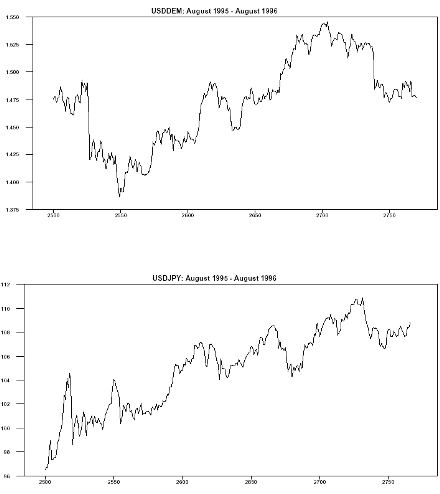In this section we test the profitability of our forecasting model. Since the stochastics is a trading rule, rather than a forecasting model, we view this as a more appropriate method of assessment than the acadmic industry’s benchmark, the random walk26.
In order to construct profitability estimates, our forecasting model has to be transformed into a trading model by defining a vector that issues exactly defined trading signals. Since our models work most successfully at the one-day ahead horizon, a Buy signal (Long position) is issued if the one-day ahead forecast exceeds the current Close ct and a Sell signal (Short position) is given if tomorrow’s forecast lies below the current Close ct.

The Stochastics, on the other hand, can be traded in many different ways. However, since all of these strategies are effectively variations of the following two strategies, we focus on them here. (1) Concentrating on %K alone, the Stochastics can be treated as a so-called Overbought-Undersold Indicator, where a Buy signal is given if the Stochastics fall below values of 30 and a Sell signal arises if the Stochastics rise above 70 (Stochastics 70/30).
(2) Alternatively, many traders use the intersection between %K with its smoothed version %D as a trading system (Stochastics Crossover). In this case, a Long signal is given, if %K rises above %D and a Short signal corresponds to a fall of %K below %D.
Since the Stochastics belong to the family of contra-trend indicators and the majority of studies about technical analysis focus on trend-following trading systems, a simple trend-following trading model based on a 10 and a 20 day Moving Average was additionally taken into consideration. This trading model issues a Long signal if the 10 day Moving Average rises above the 20 day Moving Average.
A Short signal occurs if the shorter term Moving Average falls below the longer term Moving Average. Since we did not choose the 10/20 day specification of the MA nor the 14 day specification of the Stochastics on grounds of profitable ex post optimisation, the ex ante application of these two specific technical trading rules comes close to a real world experiment.
We assess the profitability of the 4 different trading models starting from the simple profitability of following the trading signals and then add further aspects to the analysis, by including a Buy & Hold benchmark and considering various aspects of risk.

26 As explained earlier, the Stochastics calculates an indicator that reveals over-bought and undersold situations. The Stochastics formula does not allow derivation of a point forecast.
Prof. Ronald MacDonald, Prof. Norbert Fiess
Next: Profitability
Summary: Index